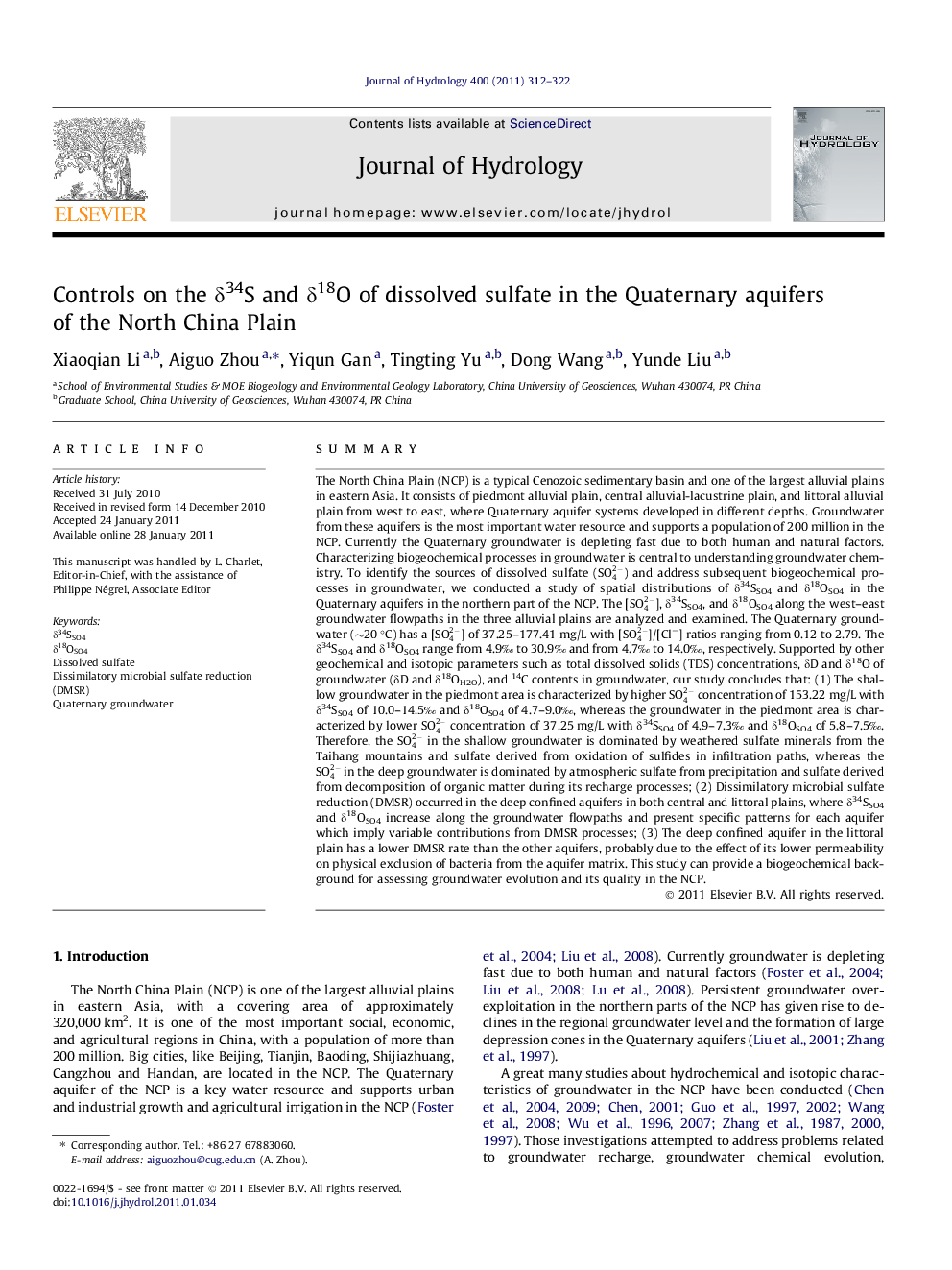| کد مقاله | کد نشریه | سال انتشار | مقاله انگلیسی | نسخه تمام متن |
|---|---|---|---|---|
| 4577728 | 1630027 | 2011 | 11 صفحه PDF | دانلود رایگان |

SummaryThe North China Plain (NCP) is a typical Cenozoic sedimentary basin and one of the largest alluvial plains in eastern Asia. It consists of piedmont alluvial plain, central alluvial-lacustrine plain, and littoral alluvial plain from west to east, where Quaternary aquifer systems developed in different depths. Groundwater from these aquifers is the most important water resource and supports a population of 200 million in the NCP. Currently the Quaternary groundwater is depleting fast due to both human and natural factors. Characterizing biogeochemical processes in groundwater is central to understanding groundwater chemistry. To identify the sources of dissolved sulfate (SO42-) and address subsequent biogeochemical processes in groundwater, we conducted a study of spatial distributions of δ34SSO4 and δ18OSO4 in the Quaternary aquifers in the northern part of the NCP. The [SO42-], δ34SSO4, and δ18OSO4 along the west–east groundwater flowpaths in the three alluvial plains are analyzed and examined. The Quaternary groundwater (∼20 °C) has a [SO42-] of 37.25–177.41 mg/L with [SO42-]/[Cl−] ratios ranging from 0.12 to 2.79. The δ34SSO4 and δ18OSO4 range from 4.9‰ to 30.9‰ and from 4.7‰ to 14.0‰, respectively. Supported by other geochemical and isotopic parameters such as total dissolved solids (TDS) concentrations, δD and δ18O of groundwater (δD and δ18OH2O), and 14C contents in groundwater, our study concludes that: (1) The shallow groundwater in the piedmont area is characterized by higher SO42- concentration of 153.22 mg/L with δ34SSO4 of 10.0–14.5‰ and δ18OSO4 of 4.7–9.0‰, whereas the groundwater in the piedmont area is characterized by lower SO42- concentration of 37.25 mg/L with δ34SSO4 of 4.9–7.3‰ and δ18OSO4 of 5.8–7.5‰. Therefore, the SO42- in the shallow groundwater is dominated by weathered sulfate minerals from the Taihang mountains and sulfate derived from oxidation of sulfides in infiltration paths, whereas the SO42- in the deep groundwater is dominated by atmospheric sulfate from precipitation and sulfate derived from decomposition of organic matter during its recharge processes; (2) Dissimilatory microbial sulfate reduction (DMSR) occurred in the deep confined aquifers in both central and littoral plains, where δ34SSO4 and δ18OSO4 increase along the groundwater flowpaths and present specific patterns for each aquifer which imply variable contributions from DMSR processes; (3) The deep confined aquifer in the littoral plain has a lower DMSR rate than the other aquifers, probably due to the effect of its lower permeability on physical exclusion of bacteria from the aquifer matrix. This study can provide a biogeochemical background for assessing groundwater evolution and its quality in the NCP.
Research highlights
► New data of δ34SSO4 and δ18OSO4 in large-scale Quaternary aquifers are reported.
► Possible sulfate sources are identified and biogeochemical processes are addressed.
► Specific δ34SSO4 and δ18OSO4 patterns are presented along the groundwater flowpaths.
► Variable contributions are implied from dissimilatory microbial sulfate reduction.
Journal: Journal of Hydrology - Volume 400, Issues 3–4, 11 April 2011, Pages 312–322